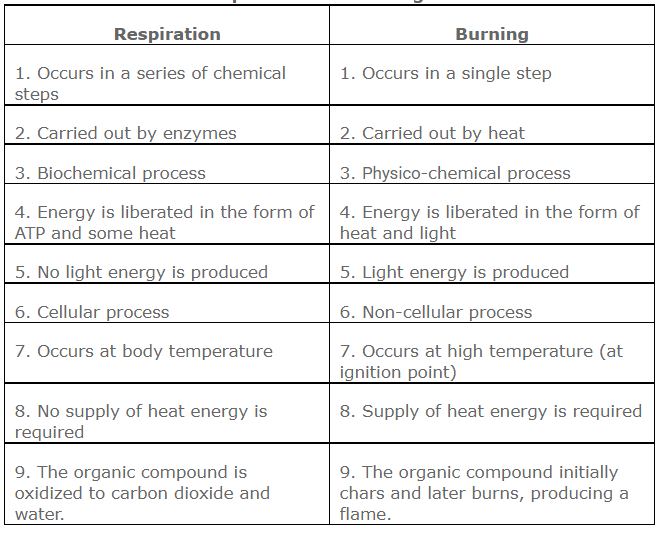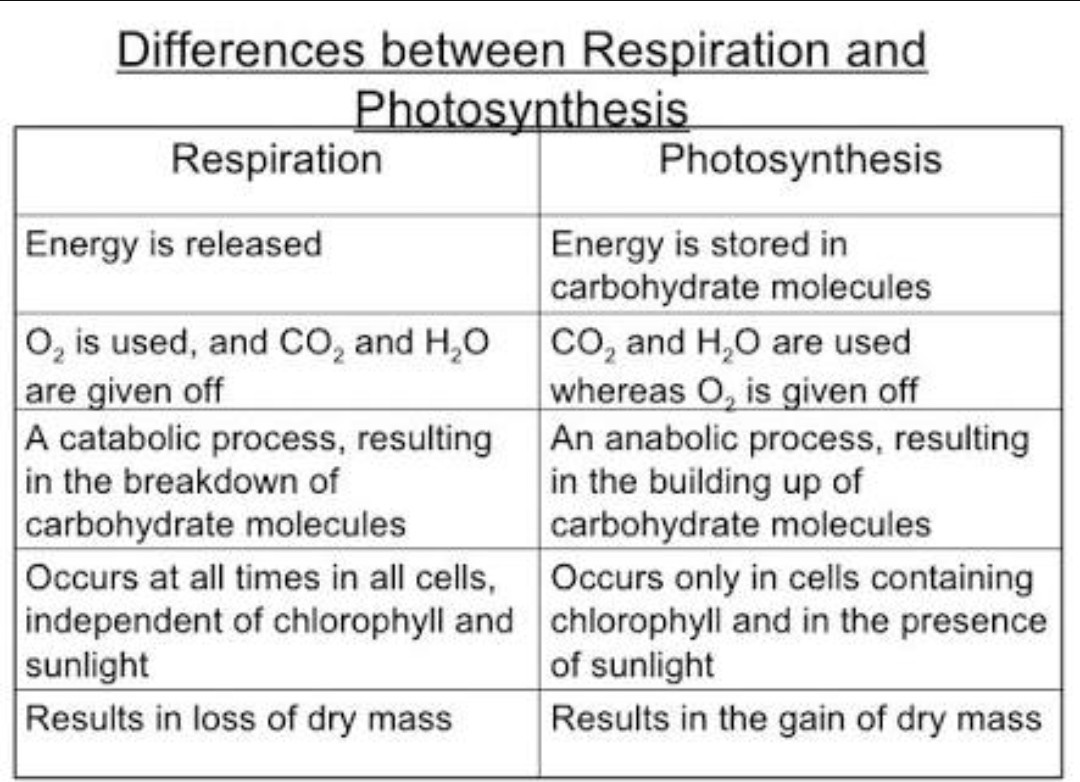Respiration in Plants
What is Respiration?
All living cells in a plant, as well as those in animals, require energy for various body activities.
For example, building up proteins from amino acids, making starch from glucose, absorbing minerals from the soil, or laying down cell walls by the plant cell, are all such activities that require energy.
This energy is made available by the breakdown of glucose a simple carbohydrate.
This chemical breakdown occurs by utilizing oxygen.
There are three important characteristics of respiration in this equation.
The breakdown of glucose (C6H l2 O6) to carbon dioxide and water does not occur in a single step but in a series of chemical steps. These steps occur in two major phases-
Glycolysis (glucose —+ pyruvate) occurring in the cytoplasm
Krebs cycle (pyruvate —› CO2 + 6O2 + ATP) occurring in mitochondria.
Each breakdown step is due to a particular enzyme.
The energy liberated in the breakdown of the glucose molecule is not all in the form of heat, but a large part of it is converted into chemical energy in the form of ATP - a chemical substance called adenosine triphosphate.
When the energy in the form of ATP is used. the ATP is converted to ADP (adenosine diphosphate) and again when more energy is available by the further breakdown of glucose, the ADP is reconvened to AMP and so it goes on and on.
One mole of glucose on complete oxidation yields 38 molecules of ATP.
Living organisms show two types of metabolic activities:
anabolic (constructive or biosynthetic processes), it consumes energy.
catabolic (destructive or breaking down processes), it gives out energy for use by the organism.
Respiration is a breaking-down process by which a living cell oxidizes organic substances (glucose) and releases carbon dioxide, water, and energy.
Burning and Respiration:
Sometimes, respiration is compared with burning such as the burning of coal.
Both liberate energy, and both give the end products CO and water.
But this comparison is only superficial.

The Entire Plant Respires:
Every part of a plant such as the leaves, stem, roots, and even the deepest placed cell in any region respires.
Oxygen is obtained from the atmosphere through three inlets:
stomata in leaves.
lenticels in the stem.
the general surface of the roots.
Ploughing or telling of the soil creates tiny air spaces around soil particles and provides the source of oxygen for the roots.
Water-logged and compact soil does not have air spaces which affect the respiration of the roots.
During the daytime, due to photosynthesis, the leaves produce oxygen, some of which is used in respiration and the rest is diffused out.
The carbon dioxide produced during respiration in the leaves serves as a raw material for photosynthesis.
At night, even the leaves obtain oxygen from the atmosphere and give out carbon dioxide.
Hence, there appears to be some truth in the belief that one should not sleep under a tree at night.
Kinds of Respiration:
Aerobic Respiration:
Normally, free oxygen is used in respiration and there is complete oxidation of glucose with the formation of carbon dioxide and water as end-products.
Respiration proceeds only when oxygen (a constituent of air) is available and is therefore called aerobic (or oxy biotic) respiration.
Anaerobic Respiration:
Sometimes certain parts of the plants (including fruit and seeds) may temporarily respire even in the absence of oxygen.
In this type of respiration, the glucose molecule is incompletely broken down into ethanol (ethyl alcohol) and carbon dioxide with the release of a small quantity of energy.
This type of respiration is called anaerobic respiration (or anoxybiotic) as it proceeds even without oxygen.
Anaerobic respiration in any part cannot continue in a plant for more than a few days and the part ultimately dies.
But there are certain microscopic organisms such as bacteria and fungi which normally respire only anaerobically.
Even the germinating seeds when deprived of air respire anaerobically.
Experiments on Plant Respiration:
Experiment to prove that Carbon Dioxide is produced during respiration in germinating seeds.
Take two flasks A and B. Place some wet cotton wool at the bottom of each flask.
Soaked seeds (such as peas or beans) are placed in the flask (A) and an equal number of boiled dead) seeds are placed in the flask (B).
A little antiseptic (such as carbolic acid) is added to flask (B) to prevent bacterial growth on dead seeds, which would otherwise respire and release carbon dioxide.
The flasks are securely worked and left in similar conditions of light and temperature.
A few days later, the seeds in flask (A) will be found to have clearly germinated and those in flask (B) showing no signs of any germination (as they are dead).
The gases in each flask are then tested by removing the work and tilting the flask over a test tube containing limewater and then shaking up the test tube.
The expected gas carbon dioxide is heavier than air would “flow down” into the test tube.
The gas from flask (A) would turn the lime-water milky, showing the presence of carbon dioxide in it, while the gas in flask (B) will show no effect.
Therefore. the conclusion is that the germinating (respiring) seeds give out carbon dioxide.
Experiment to prove that carbon dioxide is produced by green plants during respiration.
Set up an apparatus as shown in using a small potted plant such as Geranium.
The bell jar should be placed on a glass sheet and its rim as well as all other connections should be vaselined to make them air-tight.
The outside air is drawn into the apparatus with the help of an air pump.
This air passes through the soda-lime which absorbs any carbon dioxide present in the incoming air, and the limewater (Flask A) through which it passes will not turn milky.
As the air leaves the bell jar and passes through another sample of limewater (Flask B), the carbon dioxide present in it would turn the limewater milky.
It is necessary that this experiment is carried out in the dark or that the bell jar is completely covered by a piece of black cloth to prevent photosynthesis (so that the carbon dioxide liberated in respiration is not used up in the synthesis of starch).
Experiment to prove that heat is evolved during respiration:
Take two thermos flasks and mark them (A) and (B). Take about 200 seeds (pea or bean) and soak them in water for more than 24 hours.
Divide the seeds into two equal groups.
Kill one group of seeds by boiling them, and then wash them with dilute formalin or carbolic acid to prevent bacterial decay.
Put the live germinating seeds in flask (A) and the killed ones in the flask (B).
Insert a thermometer in each flask and plug their mouths with cotton wool.
After a few hours, the thermometer in flask-A will show a higher reading, thus indicating that the germinating (live and respiring) seeds give out heat.
The thermometer in the flask (B) will not show any rise in temperature.
Respiration Contrasted with Photosynthesis:
In many respects, respiration and photosynthesis ln plants are distinctly opposite processes.
The requirements of one are the products of the other and therefore, they are complementary to each other.
This is the reason why we cannot conduct an experiment on plant respiration during the daytime, in light.

Respiration in Plants compared with Respiration in Animals:
The basic aspects of respiration are same in all organisms.
However, there are some differences in respiration in plants and animals.
For example, in plants there is no gaseous transport, the respiratory gases simply diffuse in and out by cell-to-cell diffusion. (In animals, the blood transports respiratory gases).
One of the end products of anaerobic respiration in plants is ethanol/ethyl alcohol while in animals it is lactic acid.
In plants, the process produces little heat as compared to animals.